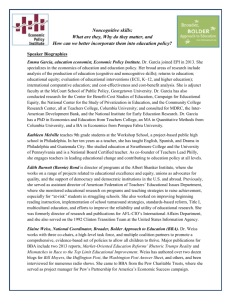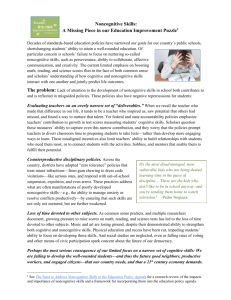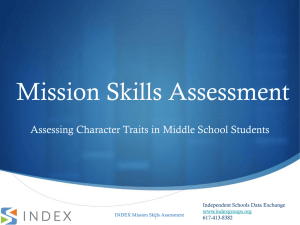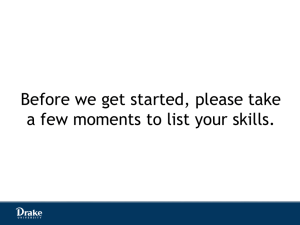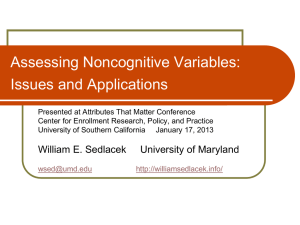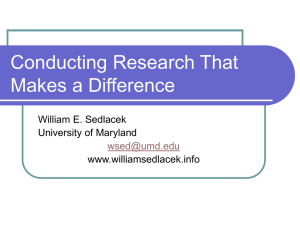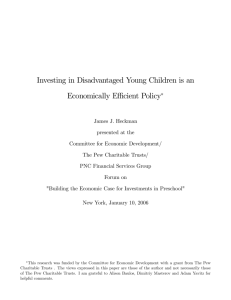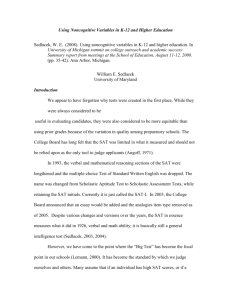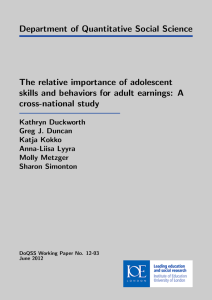Research and Policy - Broader, BOLDER Approach to Education
advertisement
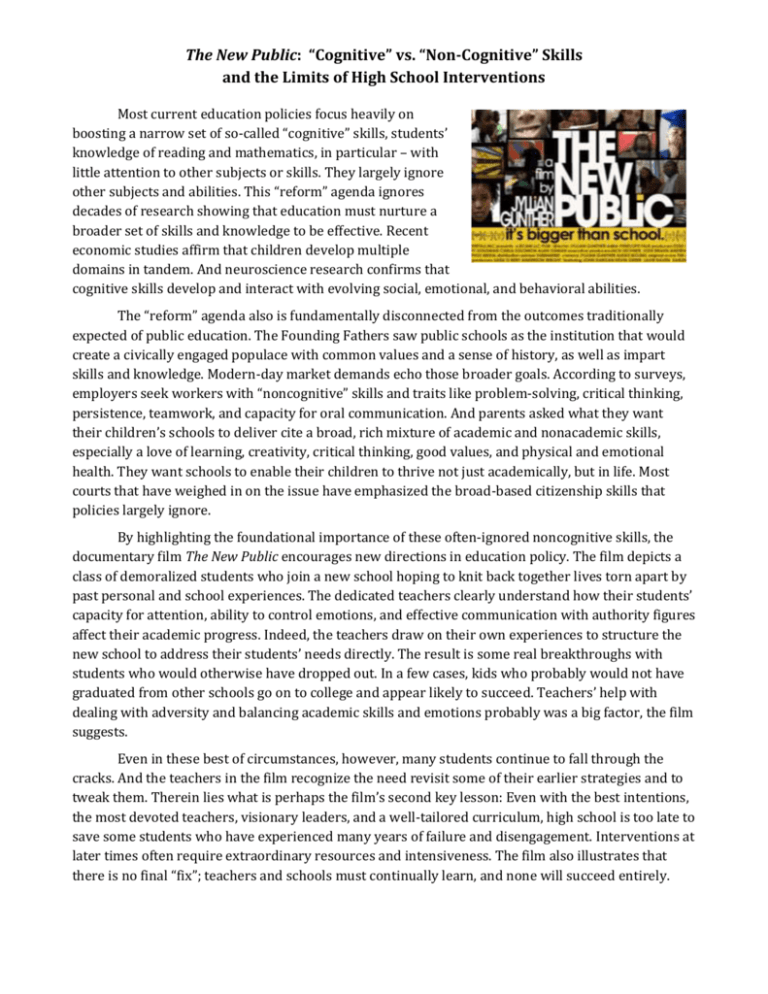
The New Public: “Cognitive” vs. “Non-Cognitive” Skills and the Limits of High School Interventions Most current education policies focus heavily on boosting a narrow set of so-called “cognitive” skills, students’ knowledge of reading and mathematics, in particular – with little attention to other subjects or skills. They largely ignore other subjects and abilities. This “reform” agenda ignores decades of research showing that education must nurture a broader set of skills and knowledge to be effective. Recent economic studies affirm that children develop multiple domains in tandem. And neuroscience research confirms that place an image, maybe from the film cognitive skills develop and interact with evolving social, emotional, and behavioral abilities. or the logo, or a photo that conveys one orthe both of the key messages of The “reform” agenda also is fundamentally disconnected from outcomes traditionally the brief. expected of public education. The Founding Fathers saw public schools as the institution that would create a civically engaged populace with common values and a sense of history, as well as impart skills and knowledge. Modern-day market demands echo those broader goals. According to surveys, employers seek workers with “noncognitive” skills and traits like problem-solving, critical thinking, persistence, teamwork, and capacity for oral communication. And parents asked what they want their children’s schools to deliver cite a broad, rich mixture of academic and nonacademic skills, especially a love of learning, creativity, critical thinking, good values, and physical and emotional health. They want schools to enable their children to thrive not just academically, but in life. Most courts that have weighed in on the issue have emphasized the broad-based citizenship skills that policies largely ignore. By highlighting the foundational importance of these often-ignored noncognitive skills, the documentary film The New Public encourages new directions in education policy. The film depicts a class of demoralized students who join a new school hoping to knit back together lives torn apart by past personal and school experiences. The dedicated teachers clearly understand how their students’ capacity for attention, ability to control emotions, and effective communication with authority figures affect their academic progress. Indeed, the teachers draw on their own experiences to structure the new school to address their students’ needs directly. The result is some real breakthroughs with students who would otherwise have dropped out. In a few cases, kids who probably would not have graduated from other schools go on to college and appear likely to succeed. Teachers’ help with dealing with adversity and balancing academic skills and emotions probably was a big factor, the film suggests. Even in these best of circumstances, however, many students continue to fall through the cracks. And the teachers in the film recognize the need revisit some of their earlier strategies and to tweak them. Therein lies what is perhaps the film’s second key lesson: Even with the best intentions, the most devoted teachers, visionary leaders, and a well-tailored curriculum, high school is too late to save some students who have experienced many years of failure and disengagement. Interventions at later times often require extraordinary resources and intensiveness. The film also illustrates that there is no final “fix”; teachers and schools must continually learn, and none will succeed entirely. Brief research findings Noncognitive skills are the foundation for learning. A growing body of research at the confluence of multiple disciplinesi highlights the importance of noncognitive skills as predictors of learning. A metaanalysis of socio-emotional learning interventions found that participating students exhibited higher achievement.ii Ongoing research conducted at the Economic Policy Institute suggests that noncognitive skills improve cognitive performance, which, in turn, further boosts noncognitive skills. Beyond school, noncognitive skills influence later earnings.iii In general, then, as The New Public shows, these skills are predictive of success in life.iv Early intervention matters. Research from multiple disciplines confirms that critical connections and foundations for learning are established long before kindergarten. vvi The capacity to trust, to interact with others, and to translate experiences into knowledge are among fundamental building blocks for learning set in place in these early years.vii The recent surge of interest in ensuring that children read at grade level by third grade (when they transition from “learning to read” to “reading to learn”) reflects a reality illustrated in the film: Students who Source: Heckman 2008ix have not yet mastered the basics by third grade often face insurmountable odds.viii In addition to not learning to read, years of “failure” have ingrained in these students the belief that they cannot succeed. With each year of “failure,” efforts to overcome these odds require increasing amounts of personal, time, and economic resources. How education policy needs to change Development of noncognitive skills must be a fundamental goal of education Policies must better support parents’ work to nurture children’s social and emotional capacities Social-emotional learning must also be a central focus of schools and embedded in curriculums Focus on a broader portfolio of assessment tools that incorporate noncognitive development Enact policies to engage and re-engage at-risk students, especially at the middle and high-school levels, through measures that target student motivation and enhance school climate. Advance alternative disciplinary policies that address the emotional challenges behind problem behaviors and that keep students in school. Education policy must prioritize preventive, foundation-laying over remediation/catch-up Federal policies should support and enhance state-level investments in early childhood development Ensure intensive, enriching, holistic, “literacy-soaked” curriculum, classrooms in early years Think more broadly. About “expert” input: Learn from and structure school based on educators’ experiences. About school reform: Engage parents and students in a multifaceted, comprehensive educational improvement process. About research: Reconnect policy with evidence based on real-life experiences and research. Almlund, M., A.L. Duckworth, J.J. Heckman, and T.D. Kautz (2011). "Personality Psychology and Economics." Handbook of the economics of education. Amsterdam: Elsevier, and Borghans, L., A.L. Duckworth, J.J. Heckman, and B. ter Weel (2008). "The Economics and Psychology of Personality Traits." Journal of Human Resources 43, no. 4 (Fall): 972-1059. ii Durlak, J. A., R. P. Weissberg, A. B. Dymnicki, R. D. Taylor, and K. B. Schellinger (2011). "The Impact of Enhancing Students’ Social and Emotional Learning: A Meta-Analysis of School-Based Universal Interventions." Child Development 82, no. 1: 405-32 iii Gintis, Herbert (1971). "Education, Technology, and the Characteristics of Worker Productivity." American Economic Review 61, no. 2: 266-79. iv Heckman, James J, and Tim Kautz (2012). "Hard Evidence on Soft Skills." Labour Economics. v Hart, Betty and Risley, Todd R. (1995). Meaningful Differences in the Everyday Experiences of American Children. vi Shonkoff, Jack P. & Deborah A. Phillips (eds) (2000). From Neurons to Neighborhoods: The Science of Early Childhood Development. National Academies Press. vii Center on the Developing Child, Harvard University. In Brief: The Science of Early Childhood Development. viii Annie E. Casey Foundation (2011). Third Grade Reading Success Matters. ix James J. Heckman & Lance J. Lochner & Petra E. Todd (2008). "Earnings Functions and Rates of Return," Journal of Human Capital, University of Chicago Press, vol. 2(1), pages 1-31. i
